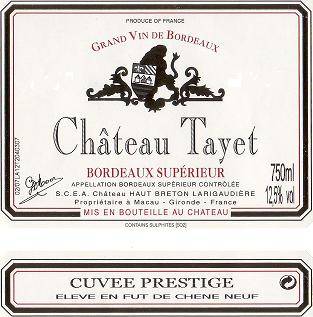 Château Tayet’s present name dates back from 1994. Before that period, the estate was known as Cru de Noë (owned by Raymond fils) and later as Château Les Charmilles.
Château Tayet’s present name dates back from 1994. Before that period, the estate was known as Cru de Noë (owned by Raymond fils) and later as Château Les Charmilles.
When the owner, M. Marc Raymond, manager of Château Haut Breton Larigaudière, decided to retire in 1993, the De Schepper family took over the management of Les Charmilles, which amounted to 7 hectares at the time.
The current managers, the SCEA (Société Civile d’Exploitation Agricole) Château Haut Breton Larigaudière, decided to change the name to “Tayet” because several other estates in Bordeaux have a name similar to “Les Charmilles”.
Jacques De Schepper and his general manager, Jean-Michel Garcion, were fully aware of this estate’s potential from the very first moment and have done their utmost to make the most of it. Their goal was to combine the wine’s natural concentration and elegance with the qualities of smoothness and finesse. The estate expanded twice in 1999, and the total area under vine amounted to 10 hectares in 2003.
Château Tayet is now château-bottled and Jean-Michel Garcion has made a Cuvée Spéciale since 1994. This wine is barrel-aged (for about 12 months in 50% new oak barrels). Numerous tasters have acknowledged Château Tayet’s great success.
